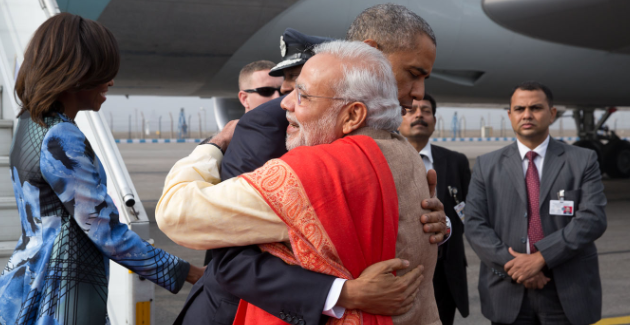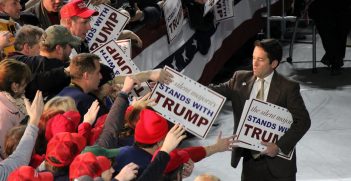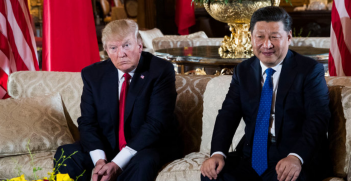Visas Won’t Derail Modi’s Meeting with Trump

The Trump administration’s decision to restrict working visas has affected India more than anywhere else and will mark the first meeting between Prime Minister Narendra Modi and President Donald Trump. However, it’s unlikely to stop the new warmth between the US and India.
Indian Prime Minister Narendra Modi is in the US on 25-26 June to meet President Donald Trump for the first time. The US-India relationship has witnessed an unprecedented convergence of interests over the past two decades, but this US visit by Modi is against the backdrop of sudden strain in the relationship. The strain has been caused mainly by the US move to curb H1B visas and Trump’s remarks against India (along with China) when he announced his decision to withdraw the US from the Paris climate accord. Although the climate change issue won’t figure prominently, H1B visas—which enable US employers to temporarily take on foreign workers—will be a major issue in the discussion.
H1B visas
In recent years, immigration has been at the forefront of Western politics. The US has witnessed a spate of attacks on ethnic minorities including on the Indian-American community. The rise of parochial nationalism and protectionism has influenced debates on the issues of immigration and demands to keep jobs for American people, including by curbing the H1B visa program.
The restrictions on the H1B visa program are likely have a massive impact on US-India economic ties, triggering concern particularly in the US$147 billion (AU$195 billion) Indian IT industry. India is the largest recipient of H1B visas: nearly 60 per cent of H1B visas (about 65,000) go to Indians, mostly to work in the IT sector. India exports IT services worth around US$110 billion each year, and the US is India’s number one destination. Indians with H1B and L1 visas (those enabling the transfer of a company employee from an overseas office to the US) add US$1 billion each year to the US economy. The Indian IT industry directly and indirectly provides some 411,000 jobs in the US, including 300,000 held by US citizens and permanent residents, while paying some US$5 billion in taxes every year.
Although Indian IT companies are taking measures to manage the impending crisis, such as excluding workers with little experience from applying for an H1B visa, the issue is now at the legislative level. Four legislative measures to curtail H1B visas are before the US congress. For example, a bipartisan bill, the ‘Keeping American Jobs Act’, has been introduced to the House of Representatives. The bill intends to stop employers awarded temporary visas through the H1B program from using them to train workers in the US and then move those jobs to another country.
Indian lobbying
To protect the program, the Indian government is negotiating with high-level US officials as well as resorting to lobbying. In 1993, India’s lobbying efforts got a substantial boost with the formation of the India caucus in the US house of representatives. Over the past two decades, the Indian lobby group has emerged as one of the most influential minority lobby groups, arguably second only to the Jewish lobby. Backed by a wealthy and professionally successful 3 million-strong Indian-American community and the India caucus, it has promoted US-India relations. India has invested a lot in lobbying efforts in the US over the past two decades and Prime Minister Modi has recently revitalised it. It could play a huge part for the IT sector.
This isn’t the first time that Indian lobbyists have been concerned about potential changes to H1B visa rules. However, this newest move to curb the outsourcing of jobs and limit the entry of skilled workers to the country is not just an initiative; it is likely to pass through Congress. This time the Indian lobby may not succeed in blocking all these legislative efforts to curb H1B visas.
From prickliness to partnership
The story of US-India ties is not dependent on H1B visa or the climate change issue. US-India relations have evolved from being an acquaintance marked by distrust during the Cold War to a strategic partnership that is only deepening. It is marked by the historic nuclear deal, increasing defence and military ties, and growing business and professional interactions. Shared security interests, including concerns about Chinese military ascendancy and the post-9/11 terrorist threat environment, have led to a convergence of strategic interests between India and the US. India’s economic liberalisation has further strengthened interaction between the two countries.
There have been some sources of strain in the last few years, including India’s nuclear liability bill in 2010 and the diplomatic row in late 2013 concerning Devyani Kohbragade’s treatment of her maid while stationed in New York. However, Prime Minister Modi’s four US visits and multiple meetings with President Obama have revitalised the US-India strategic partnership.
Strategic and economic convergence
Welcoming Modi’s US visit, the White House spokesperson recently listed “fighting terrorism, promoting economic growth and reforms and expanding security cooperation in the Indo-Pacific region” as common priorities for the two countries. The Indian side hopes the meeting will “provide a new direction for deeper bilateral engagement”. This augurs well for the US-India relationship under the Trump administration.
In fact, the US-India relationship is comprehensively intertwined, and its derailment is almost impossible. There have been comments from the Trump administration that have bolstered the US-India relationship on global security concerns, notably terrorism and the emerging strategic challenges in the Indo-Pacific region. China’s military posture continues to be a concern for both countries; there have been multiple talks, visits and exchanges between the two nations on this front. On the issue of terrorism and Islamic radicalism, the Trump administration has often mentioned India as a victim of terrorism and has continued counterterrorism cooperation that began in 2000.
Trump wants to cut deals with other countries directly. Trump’s questioning of various multilateral arrangements, including the North American Free Trade Agreement (NAFTA) and the Trans-Pacific Partnership (TPP), may produce bilateral arrangements with countries such as India. Both Modi and Trump have a business-oriented administration style, and this may help US-India trade to reach the target of US$500 billion set by Obama and Modi last year, up from the current level of US$100 billion annually.
The present bonhomie in US-India relations will likely continue. It’s a natural partnership grounded in the synergies between the world’s two largest democracies as well as their strategic convergence. New Delhi has become an indispensable partner of Washington on a range of emerging geopolitical challenges. What India provides to America, no other country in the world offers. The ties between the two nations are very much institutionalised, and it will be hard for any US president to damage them.
Dr Ashok Sharma is an adjunct faculty member at the Australian Defence Force Academy, University of New South Wales, and deputy chair of the New Zealand Institute of International Affairs, Auckland. He is the author of ‘Indian Lobbying and its Influence in US Decision Making: Post-Cold War‘ (Sage, 2017).
This article is published under a Creative Commons Licence and may be republished with attribution.





